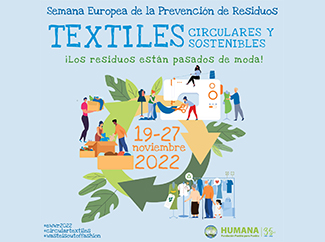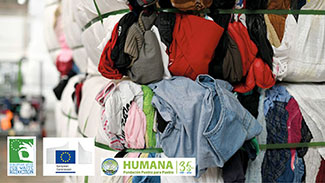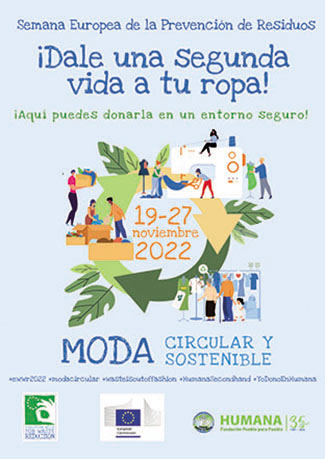consent_cookie
Duración: 1 year
Stores the user's cookie consent state
12-11-2022
"Change the way you use and buy clothes" is the slogan chosen by Humana to participate in the European Week for Waste Reduction. It is an action that will be carried out mainly in the entity's sustainable fashion stores, and which consists of raising public awareness of the importance of sustainability and the safe and transparent management of garments and footwear that we no longer use.
The objective of the European Week for Waste Reduction which receives the support of the LIFE+ program of the European Commission and is held from November 19 to 27, is to organize awareness-raising actions on waste prevention during the same week and throughout Europe.
The 2022 edition focuses on textiles to highlight the strong impact it has on our planet, but, above all, to inspire actions that bring more circularity to this sector. This 14th edition of the Week has as its generic motto: “Circular and sustainable textiles. Waste is out of fashion!”
A relevant sector for the European economy
From the organization of the Week they remember that the textile is a relevant sector for the EU economy, in terms of turnover, employment and workers. In 2019, Europeans spent an average of 600 euros on clothes, 150 on footwear and 70 on home textiles (this figure decreased in 2020 due to the Covid19 pandemic and the restrictions imposed).
In Spain, each citizen gets rid of between 20 and 30 kg of textile annually. According to the most recent reports, more than one million tons of textile waste is generated annually, but only 110,000 tons are collected to promote its reuse or recycling. The rest ends up in containers that are not for clothes.
Given this scenario, the actions promoted in the European Week for Waste Reduction want to raise awareness about "the enormous role that the textile sector plays in climate change and how each of us can contribute to reducing the waste produced by this sector".
“Not only citizens, as consumers, can influence it, for example, by changing the way they wear and buy clothes. Public authorities, private companies and NGOs can be protagonists in the transition towards a more circular textile industry, promoting, supporting and guiding new solutions for the production, use, disposal and reuse of textiles”, they affirm from the organization of the event.
Humana's campaign: "Change the way you wear and buy clothes"
Humana promotes a set of activities to raise awareness about the safety and transparency of the management it carries out in the field of used textiles. The campaign "Change your way of using and buying clothes" aims to increase the number of customers who acquire sustainable habits in relation to used clothing. Those who want to get rid of it can do so in optimal safety conditions and with the confidence that their garments will follow a transparent management process. At the same time, we see how the number of customers who bet on sustainable fashion in second-hand clothing stores is increasing.
With the label #YoDonoEnHumana, the entity encourages an increase in clothing donations in its establishments, where it has a container inside.
EU strategy for textiles
The European Commission is working on a global EU Strategy for textiles, with measures to promote the percentage of selective collection, reuse and recycling of textiles. In Spain the level of selective collection of textile waste barely reaches 12%. An alarmingly low figure, especially considering that the reuse and recycling of textiles contribute to saving resources, protecting the environment and combating climate change. They reduce waste in controlled deposits and incineration plants and, consequently, the emission of greenhouse gases.
And it is that the textile and clothing industry is one of the most polluting sectors, along with housing, transport and food. This is due to the strong impact it has on land use, water pollution, and even greenhouse gas emissions. This sector has a high environmental and social impact in all phases: from production, through distribution, use and post-use (collection, classification, recycling and final management of waste, which most of the time is related to incineration and landfills).
The textile and clothing sector is the fourth category with the highest pressure in terms of the use of raw materials and water. For example, producing a pair of jeans requires 7,000 liters of water and a T-shirt requires 2,700 liters, which is equivalent to the drinking water consumption of one person in 2.5 years.
CO2 emissions when producing textiles
The production process generates 15 to 35 tons of CO2 equivalent per ton of textile produced. The upstream value chain of clothing, footwear and home textiles consumed in the EU is the fifth most pressured category of greenhouse gas emissions.
Environmental impacts in the production phase are also related to the cultivation and production of natural fibers (cotton, hemp and flax) in terms of land and water use, fertilizers and pesticides; but also with the production of synthetic fibers (polyester and elastane) in relation to the use of energy and chemical raw materials.
In addition to this environmental effect, production is linked to social repercussions in terms of wages, working conditions and the working environment in textile factories.
Use and maintenance refers to when the textile is purchased and reaches consumers (without taking into account the entire transport phase) it requires the use of energy and water, but also detergents. Through washing, chemicals and microfibers are released into the wastewater. When washed, textiles are responsible for 35% of the primary microplastics in the ocean, which is equivalent to 50 billion plastic bottles.
Regarding post-consumption, according to a study by the Federation Humana People to People, for every kg of clothes recovered and not taken to a waste treatment center for incineration or final disposal, the emission of 6.1 kg of waste is avoided. CO2. Humana recovered 18,313 tons in Spain last year, thereby avoiding the emission of 111,700 tons of CO2.


